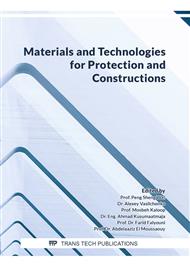p.79
p.85
p.93
p.99
p.105
p.113
p.122
p.135
p.144
Improvement of Isotropic Strength of 3D Printing-Based Self-Healing Capsules by Controlling the Position of Holes
Abstract:
Self-healing capable of storing two or more solutions is proposed to heal cracks by manufacturing capsules with a 3D printer to enable structural design, repeatable fabrication, and strength analysis. The Fusion Deposition Modeling (FDM) method was used to design, analyze, and produce new, widely used self-healing capsules at low cost. However, since the PLA extruded from FDM has low interlayer adhesion energy, the strength varies depending on the load angle applied to the laminated surface and concrete structure, which degrades the performance of the self-healing capsule. Therefore, this paper designed a structure with isotropic strength by controlling the direction and number of solution injection ports of capsules manufactured by the FDM PLA method. In addition, the intensity isotropy of the load applied through the compression test and ANSYS in the x, y, and z directions were verified. As a result, as the arrangement and number of holes were different, the standard deviation of strength according to the direction decreased by 24%.
Info:
Periodical:
Pages:
105-109
Citation:
Online since:
July 2022
Authors:
Price:
Сopyright:
© 2022 Trans Tech Publications Ltd. All Rights Reserved
Share:
Citation:



